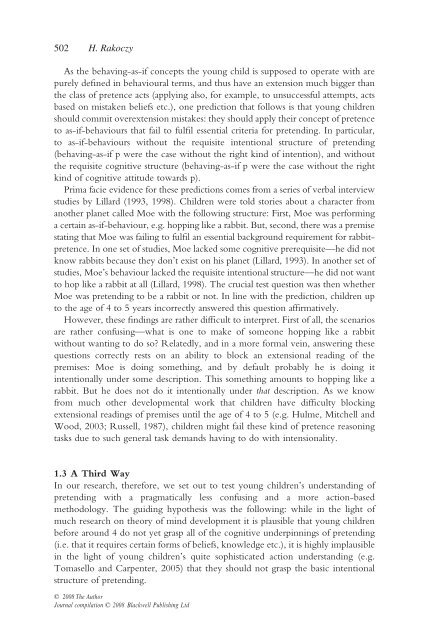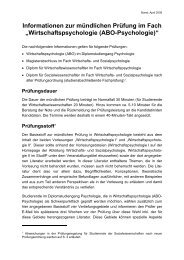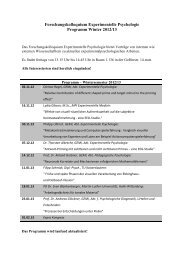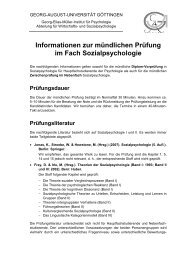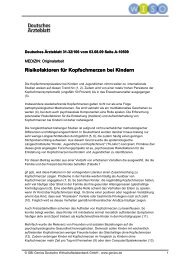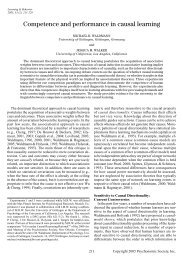Pretence as Individual and Collective Intentionality
Pretence as Individual and Collective Intentionality
Pretence as Individual and Collective Intentionality
You also want an ePaper? Increase the reach of your titles
YUMPU automatically turns print PDFs into web optimized ePapers that Google loves.
502<br />
H. Rakoczy<br />
As the behaving-<strong>as</strong>-if concepts the young child is supposed to operate with are<br />
purely defi ned in behavioural terms, <strong>and</strong> thus have an extension much bigger than<br />
the cl<strong>as</strong>s of pretence acts (applying also, for example, to unsuccessful attempts, acts<br />
b<strong>as</strong>ed on mistaken beliefs etc.), one prediction that follows is that young children<br />
should commit overextension mistakes: they should apply their concept of pretence<br />
to <strong>as</strong>-if-behaviours that fail to fulfi l essential criteria for pretending. In particular,<br />
to <strong>as</strong>-if-behaviours without the requisite intentional structure of pretending<br />
(behaving-<strong>as</strong>-if p were the c<strong>as</strong>e without the right kind of intention), <strong>and</strong> without<br />
the requisite cognitive structure (behaving-<strong>as</strong>-if p were the c<strong>as</strong>e without the right<br />
kind of cognitive attitude towards p).<br />
Prima facie evidence for these predictions comes from a series of verbal interview<br />
studies by Lillard (1993, 1998) . Children were told stories about a character from<br />
another planet called Moe with the following structure: First, Moe w<strong>as</strong> performing<br />
a certain <strong>as</strong>-if-behaviour, e.g. hopping like a rabbit. But, second, there w<strong>as</strong> a premise<br />
stating that Moe w<strong>as</strong> failing to fulfi l an essential background requirement for rabbitpretence.<br />
In one set of studies, Moe lacked some cognitive prerequisite — he did not<br />
know rabbits because they don ’ t exist on his planet ( Lillard, 1993 ). In another set of<br />
studies, Moe ’ s behaviour lacked the requisite intentional structure — he did not want<br />
to hop like a rabbit at all ( Lillard, 1998 ). The crucial test question w<strong>as</strong> then whether<br />
Moe w<strong>as</strong> pretending to be a rabbit or not. In line with the prediction, children up<br />
to the age of 4 to 5 years incorrectly answered this question affi rmatively.<br />
However, these fi ndings are rather diffi cult to interpret. First of all, the scenarios<br />
are rather confusing — what is one to make of someone hopping like a rabbit<br />
without wanting to do so? Relatedly, <strong>and</strong> in a more formal vein, answering these<br />
questions correctly rests on an ability to block an extensional reading of the<br />
premises: Moe is doing something, <strong>and</strong> by default probably he is doing it<br />
intentionally under some description. This something amounts to hopping like a<br />
rabbit. But he does not do it intentionally under that description. As we know<br />
from much other developmental work that children have diffi culty blocking<br />
extensional readings of premises until the age of 4 to 5 (e.g. Hulme, Mitchell <strong>and</strong><br />
Wood, 2003; Russell, 1987 ), children might fail these kind of pretence re<strong>as</strong>oning<br />
t<strong>as</strong>ks due to such general t<strong>as</strong>k dem<strong>and</strong>s having to do with intensionality.<br />
1.3 A Third Way<br />
In our research, therefore, we set out to test young children ’ s underst<strong>and</strong>ing of<br />
pretending with a pragmatically less confusing <strong>and</strong> a more action-b<strong>as</strong>ed<br />
methodology. The guiding hypothesis w<strong>as</strong> the following: while in the light of<br />
much research on theory of mind development it is plausible that young children<br />
before around 4 do not yet gr<strong>as</strong>p all of the cognitive underpinnings of pretending<br />
(i.e. that it requires certain forms of beliefs, knowledge etc.), it is highly implausible<br />
in the light of young children ’ s quite sophisticated action underst<strong>and</strong>ing (e.g.<br />
Tom<strong>as</strong>ello <strong>and</strong> Carpenter, 2005 ) that they should not gr<strong>as</strong>p the b<strong>as</strong>ic intentional<br />
structure of pretending.<br />
© 2008 The Author<br />
Journal compilation © 2008 Blackwell Publishing Ltd


